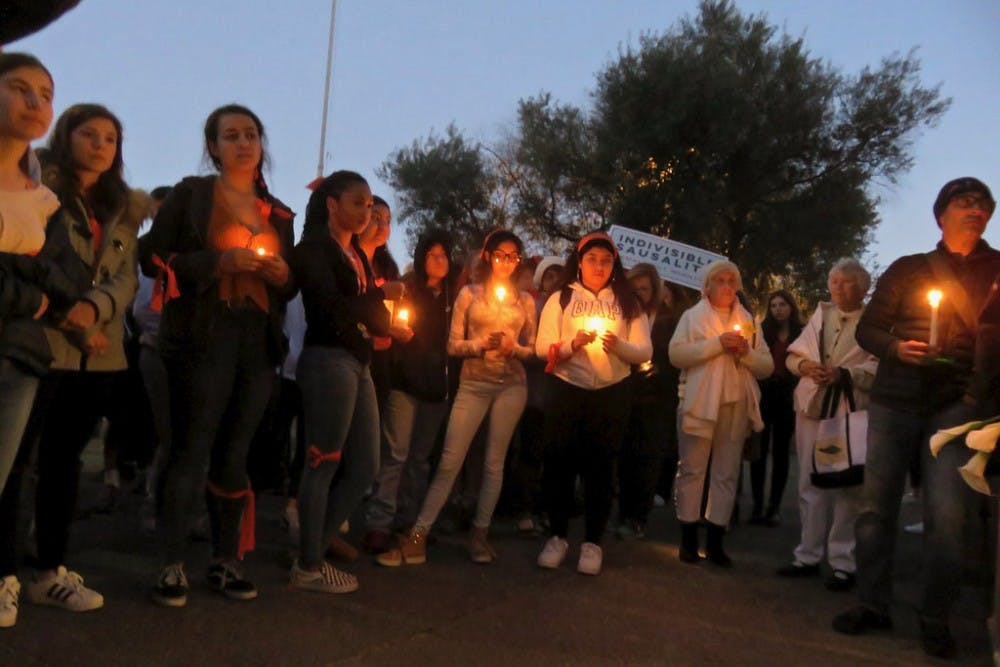The Parkland school shooting two weeks ago proved to be the deadliest school shooting since Sandy Hook in 2012. Video surveillance footage revealed that the single armed guard at the school never made an attempt to confront the shooter and never even went into the school. This has prompted the National Rifle Association (NRA) Chief Wayne LaPierre, as well as President Donald Trump, to call for salary bonuses to teachers who carry guns in schools. Trump claimed that doing so would make schools a “hardened target” and thus unappealing to school shooters. This arming of teachers would be in lieu of increased gun control measures, which has gained support after the shooting. Instead, LaPierre claimed, “The only way to stop a bad guy with a gun is a good guy with a gun.”
Public opinion reveals general disapproval for this proposed initiative. A poll from the Pew Research Center showed that 55 percent of all adults opposed allowing teachers to carry guns. Additionally, teachers themselves are almost universal in their opposition to the proposal. The National Education Association claimed that only 22 percent of its members support training and arming educators. Randi Weingarten, president of the American Federation of Teachers, said that “The response was universal, even from educators who are gun owners: Teachers don’t want to be armed, we want to teach.” Without support from teachers, it seems unlikely that any meaningful steps toward arming teachers could be made anyway.
However, we still must consider the possibility of such a proposal becoming law. If net neutrality taught us anything, it’s that public support isn’t the be-all end-all for determining the passing of legislation. Schools need to be a safe haven, not a war zone. Making schools “hardened,” as Trump puts it, would not just intimidate potential shooters, it would intimidate every child there. A gun is a symbol of threat. Even if the weapon is acting as a form of protection against a threat, it introduces and preserves the idea of threat and fear into the school’s culture. Students cannot develop a true passion for learning in such a culture. A school’s primary objective is not to teach but rather to foster a love for learning that children can take beyond their school career so that they continue to learn for the rest of their lives. If the culture is one based around fear, children will never be able to develop that love, that passion.
Even if this situation is unlikely, the introduction of Trump’s proposal into the discourse of gun control will normalize previously divisive issues. This concept is called the Overton window. This window, also known as the window of discourse, is the set of ideas that are popular, or at least acceptable. On either side of it, known as the fringes, the ideas are perceived as radical or unthinkable. The window can be shifted in either direction by proposing an unthinkable idea. Ideas that were previously viewed as radical seem acceptable in comparison. This idea is relatively common sense. In order to get what you want, you first ask for more than what you want to make what you actually want seem like the compromise.
This is most likely what will follow Trump’s and LaPierre’s call for armed teachers. Now that the most pro-gun proposal is arming teachers, a radical increase in armed resource officers or the introduction of outside security companies into public schools become normal solutions. The point is not that everyone would now simply accept these solutions because a more radical one was proposed, it is that they are considered, rationalized and given priority in discourse as compromises. However, it is very likely that these proposals would have the same effect on the school culture as armed teachers. It is obvious that schools require some amount of protection for any number of situations, but there exists a fine line between making students feel safe and making students fear a perceived imminent threat. Where exactly this line lies, no one can say right now — least of all myself.
Finally, let’s imagine a situation where this threat is indeed real and indeed imminent. Teachers are some of the most underpaid and overworked workers in the nation. Across the U.S., they are facing budget cuts, 30 or more students per classroom and staff shortages. Adding security guard to their long list of responsibilities is not feasible. Many argue it is unreasonable to expect teachers to be able to maintain full control over their classroom now, before they even have to worry about and maintain full control over a lethal weapon in their possession. Dividing their attention even more with such a deadly object could make the classroom a more dangerous place, not a safer one.
At such a cost, we must ask ourselves: Is it worth it? Is the potential for making impulsive actions more deadly worth making a school more unappealing for school shooters? It is undeniably more common for violence to result from a student’s bad day or a puberty-driven testosterone rage, than a meticulously planned and successfully executed shooting. Is the risk of creating a culture based around fear worth the infinitesimally small chance that the threat is justified? Many students come from abusive households or poverty so harsh that their only meal comes after the lunch bell. One of their last possible safe havens could be erased. Would that be worth it?
Samuel Farrar is a freshman from Brevard, N.C. and plans to major in political science. He is The News-Letter’s Social Media Editor.





